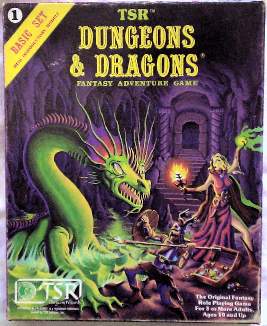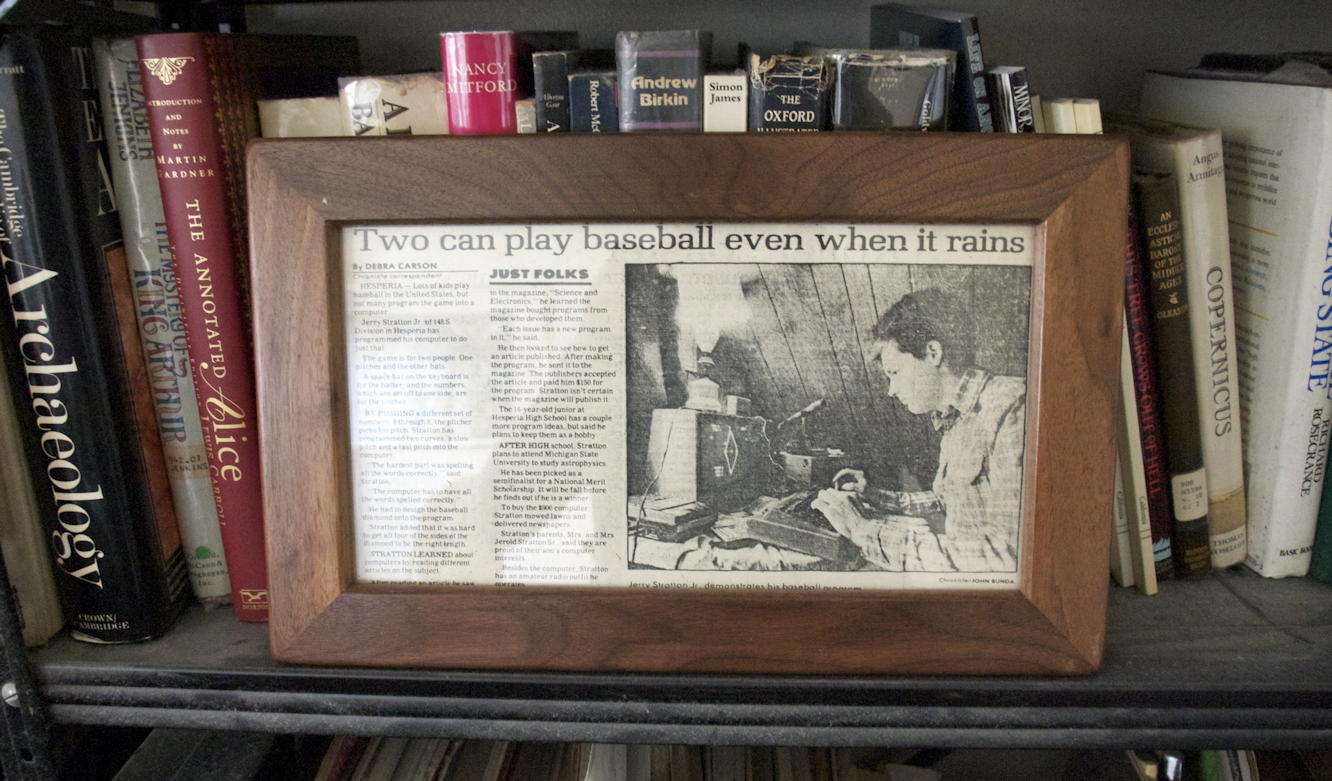Nothing will be restrained from them, which they imagine to do

Merry Christmas from 1981!
A while back, Erik Bader wrote on Google+:
I finally dug out my beat up old 1st ed PHB for a decades-later reread and I was surprised to realize most of the rules to actually play the game aren’t in there! You can’t really roll up a character (the instructions it says are in the DMG) and you can’t hit a monster (again, in the DMG).
Now, the DMG didn’t come out for what… a year or more later, correct? What the heck did players in 1978 do with this book in the meantime?
As I recall, the only piece of information really necessary from the DMG for creating characters was how to roll stats, and I expect players in 1978 just continued to roll stats however they rolled them before, probably without even noticing it was missing. I know I had trouble separating “what we did” with “what the rules were” back then whenever playing in a new game group.
I came a little after 1978, but had a limited budget. So our group used Holmes (our DM, who introduced us to the game, already had it) and the PHB1, and never noticed anything odd with that. At the time, we were overcome by a spirit of discovery and creation. It was all about “what can we do next”, not “what’s holding us back.” We barely if at all noticed anything holding us back.
It wasn’t just us in our little gaming subculture that people felt that way; it was in many ways a spirit of the times. Many of my friends were out in their garages forcing their cars to do things the manufacturers never intended them to do. In Ham Radio and CB Radio no rig was complete without some customization to take it up to 11.
And, closer to home, it was very much a programmer’s perspective, and of course many of us were also amateur programmers at the time, on a TRS-80 Model I, Apple ][, Atari 400, Commodore 64, TI99/4 or so on. Those computers really couldn’t do much, but that’s not the way we looked at them. We were always on the lookout for what more can we do? It’s absolutely amazing the kind of video game clones we got on those old computers. The TRS-80 Model I was black and white, with 128x48 “pixels”—that’s like playing a game on a four-tenths-inch by one-tench-inch square of my current mobile phone—and yet we managed to have fun playing Pac-Man clones, Armored Patrol clones, Space Invaders, and much more.
The text adventure craze came about because it provided great game play beyond the limits of the actual hardware of the time. If the computer’s graphics didn’t match what our brains expected, we would harness our brains to create what graphics we wanted.
Which is, of course, a lot like tabletop roleplaying.
That’s why it’s difficult, today, to answer questions like Which D&D is the Caverns of Thracia compatible with? We rarely, if ever, asked ourselves that question at the time.
It would be like asking which version of D&D Frank Herbert’s• The Jesus Incident• is compatible with. Whichever one we happen to be using right now.2

Portable baseball games were literally a single pixel of light moving toward the player, and batting was pressing a single button. I was paid $150 for that game.
We took it up and we mashed it all together, and, except for TSR, even the rare stuff we bought knowingly mashed things together. Thracia itself used house rules during its playtesting, was written with AD&D in mind, but then, because TSR didn’t allow licensed AD&D adventures to use house rules, was published for D&D.
TSR, of course, unknowingly mashed things together. I never cared one bit whether an adventure was written for D&D or AD&D, and I can’t recall anyone ever saying, you can’t use that Dragon article, it was written for a different version!
It wasn’t even a matter of going through it and marking up changes. We just used it.
Much of the game was played by example and learned by example. Especially at the beginning, and the rules backed it up. Go back to OD&D’s Men & Magic, and nowhere does it tell you how experience points are calculated. It gives an example, and lets you decide the rule based on the example.3
In the BX line, many of the books came with the pages pre-punched for putting in a three-ring binder. The box photo on this page isn’t my original box: I don’t have it any more. I cut the spine and created my own rulebook in a binder, a combination of Basic, Expert, and custom stuff pages on college-rule, wide-rule, and tractor feed sheets.4
Every new book was an additional option. It struck me as weird, when 3rd edition came out, that converting characters was a thing. Even given how different third edition was, I don’t think we would have bothered converting characters if it had come out in the seventies or eighties. We would have just kept using the old characters with the new rules. Any inconsistencies would have added flavor to those characters and to our game.
Thirty-five years ago tomorrow, I got the Moldvay Basic set for Christmas; I’d been introduced to the game two months earlier. I didn’t ask for the boxed set—I just asked for Dungeons & Dragons. It was all the same to us, for the most part. I spent much of Christmas Day drawing maps, creating weird monsters5 and trying to figure out where this thin booklet would take me.
Merry Christmas, every one!
The PHB was provided by us players, after I bought it from my aunt and uncle’s souvenir store where my cousins had convinced them to put in a TSR corner.
↑Apparently, James Cameron feels the same way.
↑Mind you, a later supplement, Greyhawk, called the obvious interpretation “ludicrous”, but rapidly overturning previous rules was also a feature of the day.
↑That binder is long since lost, and yes, I would love to have that sucker back.
↑Some of which, like the Petraiad, I still use. And of course the aforementioned Hooded Dashers, Nerve Runners, and Spinneretts.
↑
- The Jesus Incident•: Frank Herbert (paperback)
- “A sentient Ship with godlike powers (and aspirations) delivers the last survivors of humanity to a horrific, poisonous planet, Pandora—rife with deadly Nerve-Runners, Hooded Dashers, airborne jellyfish, and intelligent kelp.”
- Rewards and improvement in Dungeons & Dragons
- Kill monsters. Take their stuff. How has character improvement in D&D changed over the years? This article in the RPG experience series looks at changes in experience point acquisition from early D&D through later versions of the game and later games by the authors.
- Which edition(s) of D&D is the Caverns of Thracia (1979) compatible with? at Role-playing Games (Stack Exchange)
- “I can find a compatible OSR game I'm sure (I want something that has a free PDF rulebook and super-quick character creation, to suit having casual players at an open table), but I need to know what edition of D&D I'm looking for a match with.”
More Dungeons & Dragons
- In Defense of the One-Minute Round
- The six-second combat round de-emphasizes role-playing and problem solving in favor of brute force and pre-defined from-the-sheet actions.
- Critical (fantasy) race theory
- It isn’t racist to address D&D characters by their race. D&D character races are things the character can do. It is racist to imply that real world races are as inferior and superior as fantasy races. Woke racism is still racism.
- Watches in Dungeons and Dragons Fifth Edition
- Watches are actually a bit difficult in D&D 5e due to the sleep/rest rules. Watches with multiple people on each watch, for twice the eyes on target, are even more difficult.
- Surprise and initiative in Advanced Dungeons & Dragons
- For the North Texas Role-Playing Game Convention’s tenth anniversary, I ran an AD&D game; the hardest part was re-figuring out how initiative and surprise work.
- The Great Falling War, Revisited
- Delta’s D&D Hotspot revisits the falling wars, and provides a surprising bit of information about the lethality of falling.
- Six more pages with the topic Dungeons & Dragons, and other related pages
More eighties
- Hesperia Class of ’82
- The 40th reunion for the Hesperia High School Class of 1982 is July 15 through July 17, 2022. We look forward to seeing you!
- Hobby Computer Handbook: From 1979 to 1981
- Hobby Computer Handbook lived for four issues, from 1979 to 1981. Back in 1979 and 1980, I bought the middle two issues. I’ve recently had the opportunity to buy and read the bookend issues.
More old school renaissance
- North Texas RPG Con 2016
- NTRPG Con is a relatively small gaming-only convention focused on old-school games.
- Do not miss Petty Gods!
- This is a tome worthy of the gods—and that’s what it is. A tome of gods usable much as a tome of monsters, placing these petty gods—what Gods & Monsters would call spirit gods—around your sandbox’s map.
- Old School Cool
- Since I first made Gods & Monsters public over ten years ago, there’s been a groundswell of support for “old-school” D&D games. Since Gods & Monsters is compatible with adventures for original D&D and AD&D, it’s also compatible with adventures for most of these new games.
- Fight On! 7 is out (and I’m in)
- Fight On! issue 7 is out; look for a Gods and Monsters adventure inside.
- Lamentations of the Flame Princess indie publisher
- James Raggi is producing some great stuff, easily usable with Gods & Monsters.
- Three more pages with the topic old school renaissance, and other related pages
